Imaging
Encountering Plants: Pictures and Imaging in the Early Twentieth Century
“There has been a considerable development in the art of arranging flowers in the last few years,” noted the German art historian Alfred Lichtwark at the dawn of the twentieth century. He continued:
Since green leaves were considered raw, arrangers looked for brown and yellow ones, and if a flower only had green leaves, the fault was corrected by combining it with the brown leaves of another. For years in Berlin, I only saw roses with yellow or brown mahonia leaves, never with their own leaves, and it was difficult for anyone standing in front of a Berlin flower shop to convince themselves that the “arrangements” lying there on the black velvet were really produced with living flowers and not artificial ones. . . . As we know, new techniques tend to develop with incredible speed. Soon they were no longer content to use only wire, but appropriated the green, yellow, and brown paper that makers of artificial flowers wrap around the stems, bringing down the last barrier on the way to an astonishing concept. They created large sprays of curious blue flowers in inflorescences that did not follow the principles of umbel, panicle, or raceme and were of a sort that had never been seen before. If you looked more closely, you could see that they were hyacinth blossoms, torn from their stems and formed into inflorescences on long wires wrapped in green. Any other small flower that acquiesced was treated in a similar fashion. Arrangers who were particularly clever and acclaimed ultimately had even more daring ideas. They would remove individual petals to attain new forms, or they plucked away all the petals, leaving only the calyx, which in the case of dahlias created the most peculiar effects. Using wire, they were no longer limited to the form of the arrangement and could imitate all sorts of things and creatures with the building material of flowers and leaves. Flower lovers protested, and it wouldn’t have taken much to convince the most thoughtful ones among them . . . to start an association for protecting flowers. . . . However, the public had now grown proud of their florists’ abilities, which a short while before they could not stand, and you started hearing and reading about Berlin having much more to offer in the art of flower arranging than Paris or London.[1]
While some applauded the aesthetics of artificial floral creations, others would have preferred to found an association for protecting flowers. Some still firmly believed in an anthropocentric world, while others considered flowers living creatures that had their own rights. The nonhuman turn, which is apparently older than its name, challenges the purported uniqueness and superiority of human life. For thousands of years, this special status has been based on the claim of the dichotomy between humans and nonhumans—for example, between humans and plants, humans and animals, or humans and the ecosystem.[2] In the tradition of Western thought, a hierarchical distinction was made between the inorganic and the organic world, with plants being closely associated with rocks. Higher up in this hierarchal structure were animals, above them were humans, while in the top categories were celestial and divine beings. The realization that humans have never belonged to a hierarchy such as the one described in this myth is fundamentally disconcerting, as is the recognition of just how blind such concepts of superiority have made those who believe in them. So let us listen to voices and look at images that tell of a more complex relationship between humans and plants at the beginning of the twentieth century.
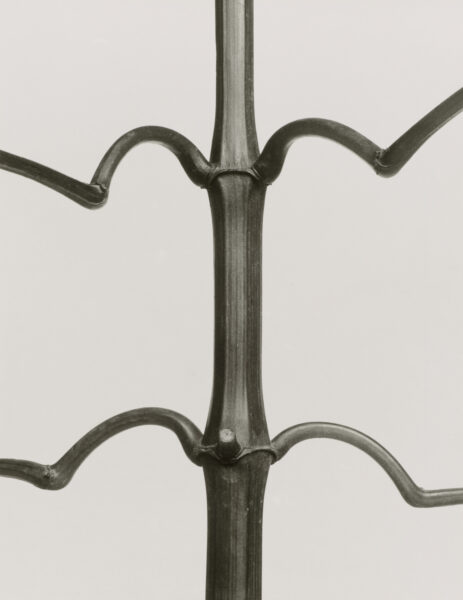
A photography book entitled Urformen der Kunst, later published in English as Art Forms in Nature, attracted a great deal of interest when it was published in 1928, to the pleasant surprise of its editor. The book contained black-and-white photographic enlargements of plant sections taken by the German photographer and sculptor Karl Blossfeldt. “The photographs,” wrote the philosopher Walter Benjamin about Blossfeldt’s pictures, “explore a completely unexpected trove of analogies and forms in the existence of plants.”[3] In fact, it was the forms and tectonics of flowers picked in Europe and northern Africa that interested Blossfeldt. He did not research their names, the places where they were found, or their use, and he most likely would not have joined an association for protecting flowers. It was his art dealer, Karl Nierendorf, who later identified the Latin names of the plants, listing them in the captions at the end of the book as if it were a herbarium. Blossfeldt separated the “wild-growing” plants from their natural habitat or from areas of the Botanical Garden in Berlin that were off-limits to the public.[4] “To achieve my goal, I went to Dahlem, paid the one-mark entry fee, and found myself in front of the . . . fenced-in system. I found a way in through a forbidden door, and then I simply stole the plant,” he wrote—intentionally or unintentionally evoking Old Testament associations with the Garden of Eden and its forbidden fruit.[5] At the time, the Botanical Central Department for the German Colonies located in the Botanical Garden was studying imported plants with the intention of intensifying the crop yields of plantations in the German colonies. After stealing the plants, Blossfeldt stuck them in modeling clay and photographed them against a neutral background so that his pictures could be used by craftspeople as reference material. To this end, he took advantage of the camera’s facility for enlargement, trimming the plants before photographing them to such an extent that they are often difficult to identify botanically, although they are technically better defined in their naked form. Judith Elisabeth Weiss notes that “the fact that they have no fungus, no aphids, no roots . . . puts the plants in a vexing state of imbalance.”[6] Nothing in Blossfeldt’s pictures suggests that the plants once had a connection to the earth, to other plants, and to animals. In 1926, Nierendorf presented the photographs in his Berlin gallery. In the Galerie Nierendorf’s white exhibition space, the plants appear as extracted, controlled artifacts.
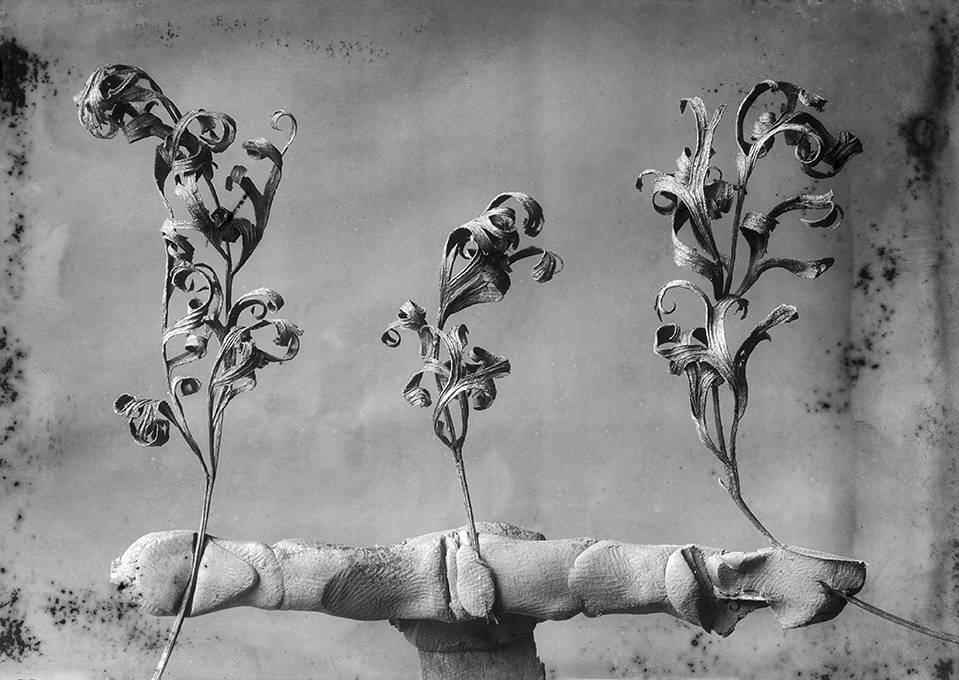
“By reducing nature to its purely material characteristics, cleansing it of symbolic meaning and social connections, modern artists are able to manipulate it in a way that was inconceivable in premodern times,” writes philosopher Alf Hornborg.[7] Photographs of individual plants against a neutral background were in fact common in the early twentieth century, as in the work of Aenne Biermann, Albert Renger-Patzsch, and Blossfeldt. You would hardly call them still lifes, as they seem too quasi-scientific in their separation, heightened by the purported objectivity of the techniques used to make them. Reduced to their form and texture, the plants in the images seem objective, static, constant. “Although the large number of ethnological studies that have flooded the German-speaking countries in the past decades with far-reaching impact indicate otherwise, the broad mass of plants completely lack understanding and are indifferent as living beings. . . . Animals are living, but plants are not—that is the general opinion,” observed the Austrian botanist Friedrich Morton in his 1920 book Pflanzenphysiologische Plaudereien.[8] While this statement might apply to Blossfeldt, the spread of botanical time-lapse films was to change this opinion for many. Between 1898 and 1900, the plant physiologist Wilhelm Pfeffer at the Botanical Institute of the University of Leipzig prepared “kinematic studies” of plants in which three days were condensed into a few seconds, highlighting the agitated back-and-forth movements of leaves against a white background.
Apart from their movements, it was the excitability of plants that gave Pfeffer reason to challenge the natural delineation between plants and animals. Excitability, which is detectable with the naked eye in the tropical mimosa, was considered a “fundamental characteristic of all living substance.”[9] Time-lapse studies of plants first became known to a broad audience through Max Reichmann’s film Das Blumenwunder (The Miracle of Flowers). The highly successful film was screened in cinemas in 1926, making it concurrent to Blossfeldt’s exhibition at the Galerie Nierendorf. Even at the Bauhaus in Dessau, the film was said to have received “unreserved applause.”[10] Philosopher and anthropologist Max Scheler wrote about his experience of watching it in the cinema: “You witness plants breathing, growing, and dying. The natural impression that plants do not have souls disappears completely. You are confronted with the unabated drama of life—the incredible effort.”[11] To others, Das Blumenwunder was as “uncanny as a nightmare” and the movements of the plants “eerie.”[12] The time-lapse shots against a black background show plants, such as rambling pumpkins and opening Strelitzia, with allegorical dance scenes and a floral ballet in between, often superimposed. Intertitles relay that plants have a pulse, like humans, and are alive, while dramatic accompanying music heightens the effect.
Scheler observed that humans and plants were related to one another through “emotional compulsion,” citing the autonomous vegetal nervous system and thus considering both from the inside.[13] Around this time, the belief that plants had a soul gained popularity, an idea that had already been proposed in the nineteenth century by the German philosopher Gustav Theodor Fechner. In 1917, Sigmund Freud had upset the notion of humans as rational and thus superior to other beings when he deemed the conscious mind only a small aspect of the human mind, the greater part of which remains largely unconscious.[14] He stated that the unconscious and the instincts—interestingly the German term triebhaft (instinctive) contains the vegetal word Trieb (shoot)—influenced humans more than the matter-of-fact rationality of Western modernism cared to admit. Jagadish Chandra Bose, a physician and botanist in Kolkata, received international attention for his books, such as Plant Autographs and Their Revelations, which was published in English in 1927 and in German in 1928. Commenting on Bose’s influence, biologist Virginia A. Shepherd writes, “If there were two scientific Wests at this time—the first materialist, mechanistic, and colonial, and the second, vitalist, ecological, or organicist, the world of plant physiologists had polarised along these lines by the late 1920s into ‘Bosephiles’ and ‘Bosephobes.’”[15] Bose developed sensitive instruments for registering the movements of plants, quantifying their production of oxygen, and documenting their internal circulation of fluids.
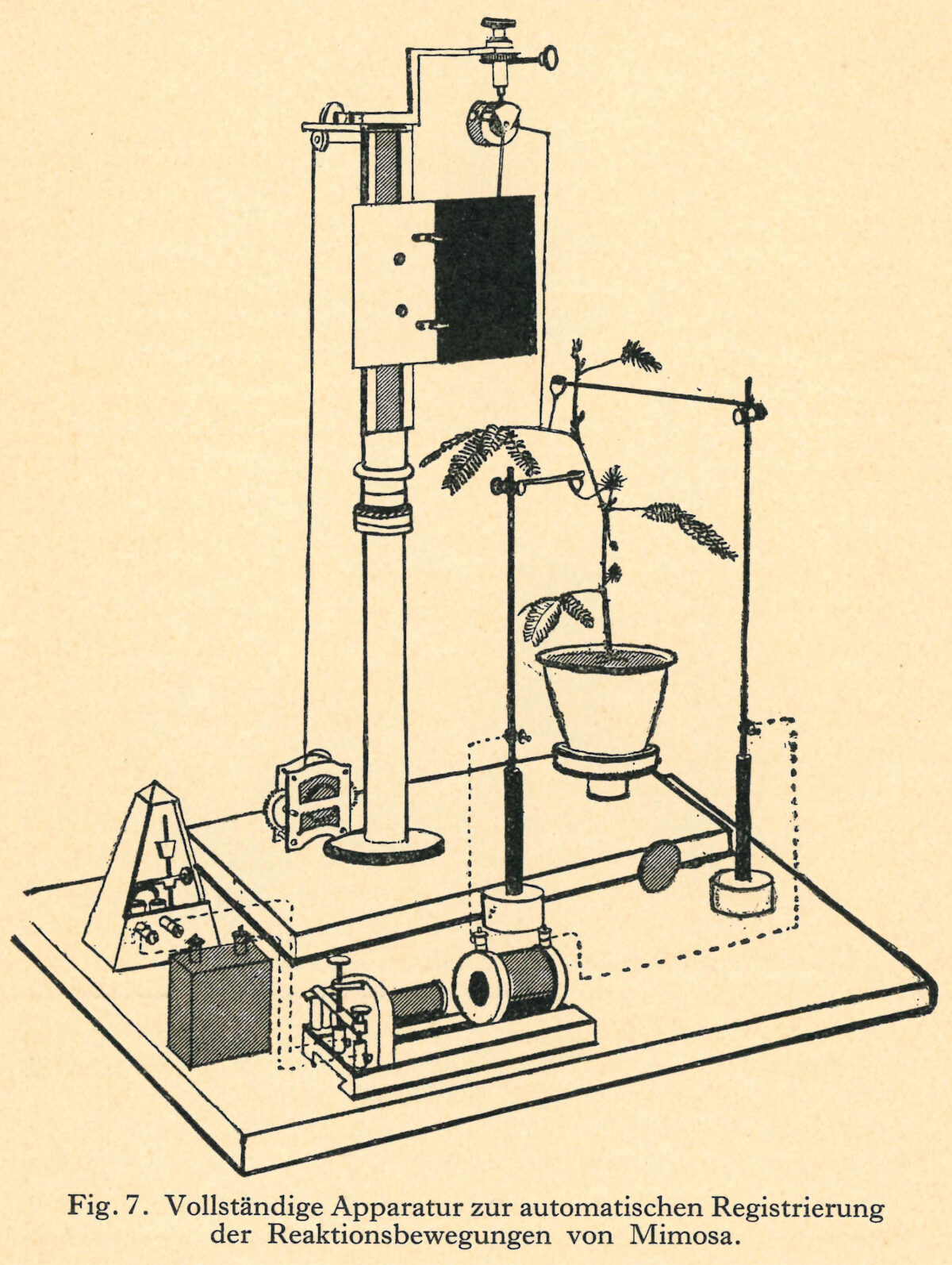
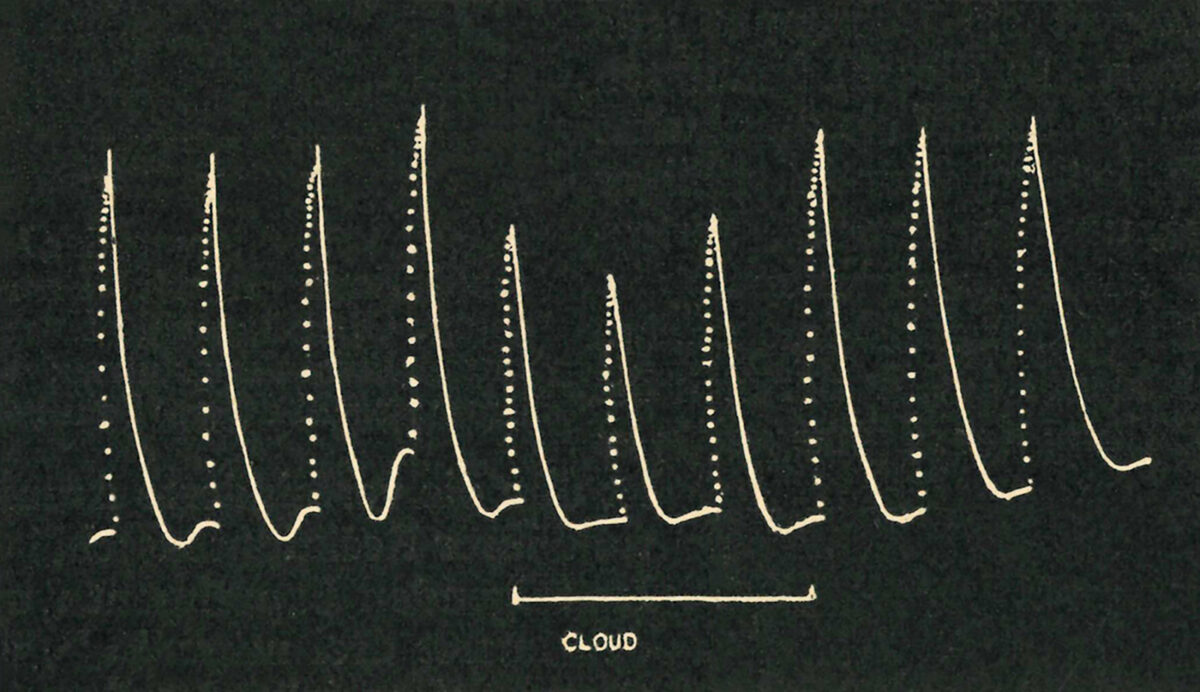
After conducting experiments on the tropical Mimosa pudica, Bose noted:
In all this, we see how human-like is plant behaviour. In certain respects, the plant may even be found to be superhuman! I was awakened to this one day when taking a record of Mimosa in my laboratory. The response I was getting was uniform; but all of a sudden, there was a depression, for which I could at first discover no cause, since all the surrounding conditions appeared to be unchanged. On looking out of the window, however, I noticed a wisp of cloud passing across the sun. The plant had perceived the slight darkening which I had not noticed. As the cloud passed by, the plant recovered its normal exuberance, as the record shows.[16]
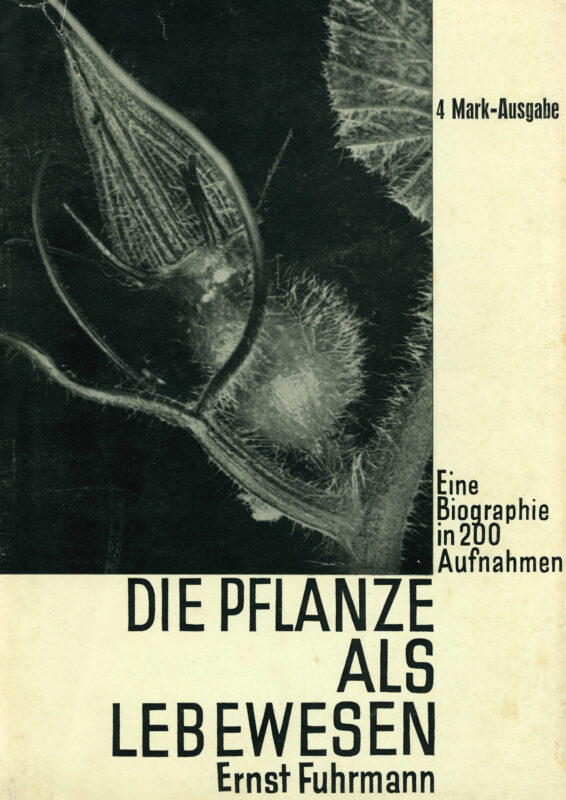
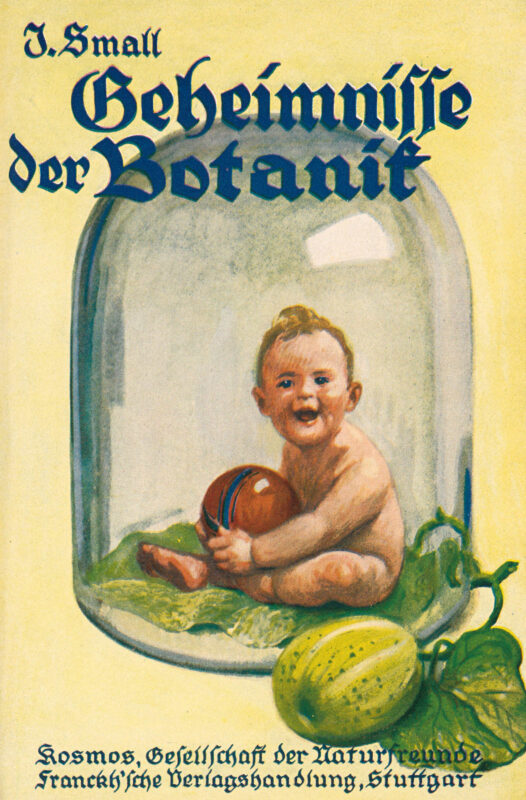
As in the case of time-lapse film, the visualization of vegetal processes through new apparatuses led to a reassessment of plants. Bose recorded the responses of plants to stimuli by attaching a thin wire to them; the lines and dots made by the wire on the dark surface of a smoked glass plate were read by Bose as the plant’s “own responsive record.”[17] Poet and photographer Ernst Fuhrmann took this idea of the authorship of plants a step further in his book Die Pflanze als Lebewesen (The plant as a living being, 1930). Against a black background, sometimes dramatically illuminated, he shows one plant portrait after another. “After examining plants for many years, we have become aware that plants do not just stand there as an aesthetic form, but that it is also a being that actively creates,” wrote Fuhrmann, who considered himself a “biosopher.”[18]
Austrian author Gustav Meyrink transformed the rumblings in popular botany into a vegetal horror story. In Die Pflanzen des Dr. Cinderella (The plants of Dr. Cinderella), a meeting between humans and plants turns into a nightmare:
I was chilled by horror, and I made my way along the curve of the corridor. Once I touched the wall and grasped a splintery wooden lattice of the sort that is used for climbing plants. There seemed to be great numbers of them growing on it, for I almost got caught in a network of stem-like vines. The incomprehensible thing was, however, that these plants, or whatever they were, seemed to be full of warm blood and felt generally quite animalistic to the touch. I put my hand in again and recoiled with a start: this time I had touched a spherical, nut-sized object that felt cold and immediately darted away. Was it a beetle? In this instant, a light flickered somewhere and illuminated the wall in front of me for a second. What I had ever experienced in terms of fear and terror was nothing in comparison to what I felt now. Every fiber of my body bellowed with indescribable disgust—a silent cry with paralyzed vocal cords that shot through my entire body like the icy cold. The wall was covered with a mesh of tendrils like blood-red veins, from which hundreds of staring eyes protruded like berries. The one that I had just touched moved back and forth with a jerking movement and glared at me maliciously. . . . They all seemed to be parts taken from living bodies, assembled with incredible art, robbed of their human animation, and brought down to a purely vegetal growth.[19]
The description of growth in Meyrink’s tale is an uncanny variant of the floral forms displayed in Berlin’s flower shops as described by Lichtwark—only here, it is human bodies that are torn apart and rearranged into vegetal forms. In the second half of the nineteenth century, Charles Darwin disrupted the idea of species as fixed categories, which was widespread in the Western world, with his theory of evolution that spoke of constant development and bifurcations and acknowledged the entangled relationship between animals and humans. Through his investigation of carnivorous plants, Darwin also proved what had previously been inconceivable within the hierarchy of the food chain: that there are, in fact, plants that eat animals and that the transitions between predator and prey within the food chain are fluid.
But what about modernism, which was viewed as a rational movement? It was literally shaken when on September 21, 1921, an explosion of unprecedented magnitude caused the ground to quake in southwestern Germany, Switzerland, and France. The tremor was felt from Zurich to Göttingen. Within a seventy-five-kilometer radius around Oppau, the location of the detonation, windows were broken, 559 people died, almost 2,000 were wounded, and about the same number lost their homes. Images of the destruction circulated throughout the world.

A crater, 165 meters long, 96 meters wide, and over 18 meters deep, was left at the site of a fertilizer silo belonging to the BASF company.[20] In 2012, Christian Haller wrote, “While today ninety percent of nitrogen production around the world requires slightly over one percent of the worldwide energy use with the Haber-Bosch process, yielding fertilizer that feeds nearly half of the world’s population, the nitrogen industry was still a quite recent development in 1921. In the nineteenth century, saltpeter containing nitrogen had for the first time been imported from Chile to supplement the natural manure from stables.”[21] The dearth of food during and after World War I could be alleviated by using nitrogen in fertilizer (incidentally, another product that used nitrogen was ammunition). With the help of science, plants could be grown quickly and productively, and many hungry people were fed. However, it was predicted that saltpeter from Chile would be depleted by 1930.[22] Did the painter Karl Schmidt-Rottluff know that the lupines he depicted in a vase had been introduced shortly before as a much-needed food crop, finding its way from Sicily to Germany in the mid-nineteenth century and quickly spreading due to its good yields?[23]
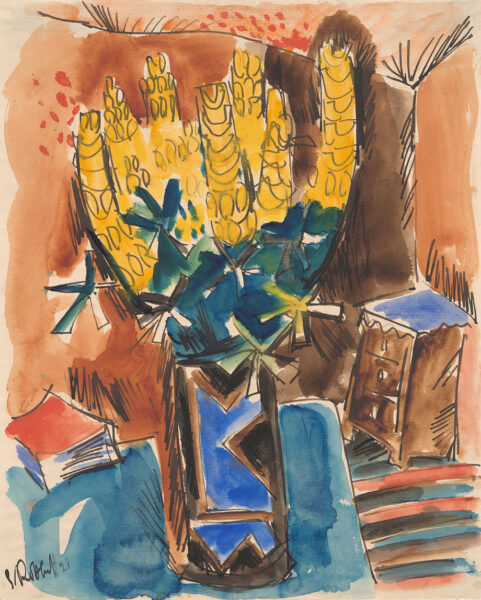
Four and a half years after the Oppau explosion, Das Blumenwunder premiered. Walter Benjamin’s analysis of the film was: “The regression from the social to the natural and biological reality appears for the first time here [in Jugendstil]—and initially just programmatically—a reality that has been confirmed increasingly ever since as a symptom of the crisis.”[24] Did the miracle of flowers and indoor gardens offer a means of escaping the crisis of inflation and instability facing the Weimar Republic?
The German journal Die Deutsche Wohnung der Gegenwart observed in 1932: “Interior spaces are no longer closed to the outside world but instead make it possible to embrace nature. . . . In open spaces, on broad terraces, and flat roofs, we form an allegiance with nature that gives us space in which to breathe. . . . In the windows, masses of curtains, which previously softened and reduced the light, no longer prevent us from having a clear view.”[25] In the painting Brown Figures in a Café (1928–29), Ernst Ludwig Kirchner painted the view of a fantasy landscape, perhaps tropical, from his Swiss mountain hut, which is recognizable due to the striped awning.
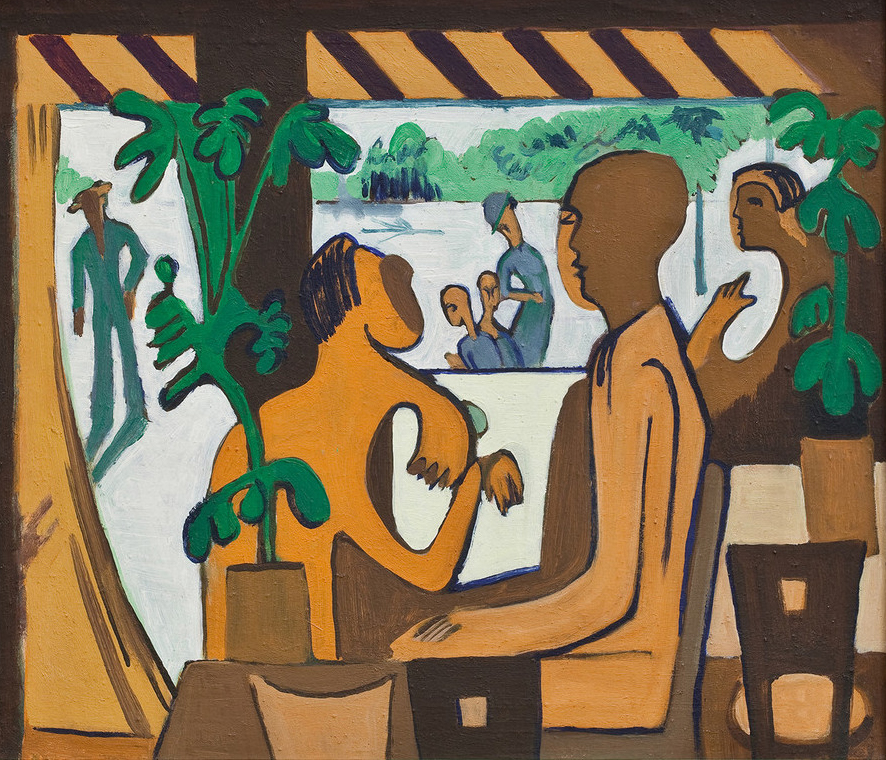
Outside, in the background, people are seen in the glaring sunlight against what appears to be a wide river and lush vegetation. In the foreground, in the interior of a café, three figures sit in the shadows—possibly Kirchner in between his partner Erna Schilling and the dancer Nina Hard, both of whom had pageboy haircuts like the figures in the painting. Two conspicuously large potted plants are positioned in front of the arched contours of the painted women. Could this be an attribute linking the women with their “ur-ego,” as the novelist Alfred Döblin in 1927 referred to nature of the sort found in the Botanical Garden in Berlin, from where Blossfeldt had stolen his ur-forms, which had given Döblin comfort and peace during the period of inflation in the Weimar Republic?[26] Kirchner, however, was ultimately unable to find such comfort and peace: in the painting, he is unremitting in his encounter with the lush green plant that reaches for the sky across from him.
- ↑ Alfred Lichtwark, Die Grundlagen der künstlerischen Bildung: Markartbouquet und Blumenstrauss, 2nd ed. (Berlin: Cassirer, 1905), 8–10. All translations, unless otherwise noted, are by Tas Skorupa.
- ↑ See Richard Grusin, ed., The Nonhuman Turn (Minneapolis: University of Minnesota Press, 2015), x.
- ↑ Walter Benjamin, “Neues von Blumen,” Die literarische Welt (November 23, 1928). Online: www.textlog.de/benjamin-kritik-neues-blumen-urformen-kunst.html.
- ↑ Karl Blossfeldt, quoted in Judith Elisabeth Weiss, Disziplinierung der Pflanzen: Bildvorlagen zwischen Ästhetik und Zweck (Berlin: Deutscher Kunstverlag, 2020), 12.
- ↑ Blossfeldt, quoted in Weiss, Disziplinierung der Pflanzen, 54.
- ↑ Weiss, Disziplinierung der Pflanzen, 110.
- ↑ Alf Hornborg, “Animismus, Fetischismus und Objektivismus als Strategien der Welt(v)erkenntnis,” in Animismus: Revisionen der Moderne, ed. Irene Albers and Anselm Franke (Zurich: diaphanes, 2012), 55.
- ↑ Friedrich Morton, Aus den Werkstätten des Lebens: Pflanzenphysiologische Plaudereien (Leipzig: Theod. Thomas, 1920), 5.
- ↑ Wilhelm Pfeffer, Die Reizbarkeit der Pflanzen (Nuremberg, 1893), 70.
- ↑ Anonymous review, Filmkurier, quoted in Ines Lindner, “Benjamin, Blossfeldt und ‘Das Blumenwunder,’” in gehen blühen fließen: Naturverhältnisse in der Kunst, ed. Lindner (Nuremberg: Verlag für moderne Kunst, 2014), 206.
- ↑ Max Scheler, quoted in Gertrud Koch, Die Wiederkehr der Illusion: Der Film und die Kunst der Gegenwart (Berlin: Suhrkamp, 2016), ##.
- ↑ Lindner, “Benjamin, Blossfeldt und ‘Das Blumenwunder,’” 220.
- ↑ On Scheler’s reception of Das Blumenwunder, see Matthew Vollgraff, “Vegetal Gestures: Cinema and the Knowledge of Life in Weimar Germany,” Grey Room 72 (2018): 68–93. DOI: 10.1162/grey_a_00252; Wolfgang Eßbach, “‘Des Menschen Tage sind wie Gras’: Ein Dissens über Wachstum in der Philosophischen Anthropologie,” in Soziologie des Lebens, ed. Heike Delitz, Frithjof Nungesser, and Robert Seyfert (Bielefeld: transcript, 2018), 199–218. DOI: 10.1515/9783839445587-008.
- ↑ Gustav Theodor Fechner, Nanna oder Über das Seelenleben der Pflanzen (Leipzig: Voß, 1848). Online: https://www.projekt-gutenberg.org/fechner/nanna/nanna.html; Sigmund Freud, “Eine Schwierigkeit der Psychoanalyse,” Imago: Zeitschrift für Anwendung der Psychoanalyse auf die Geisteswissenschaften 15 (1917): 1–7. Online: https://www.gutenberg.org/files/29097/29097-h/29097-h.htm.
- ↑ Virginia A. Shepherd, “At the Roots of Plant Neurobiology: A Brief History of the Biophysical Research of J. C. Bose,” Science and Culture (May/June 2012): 197. Online: https://www.esalq.usp.br/lepse/imgs/conteudo_thumb/At-the-Roots-of-PlantT-Neurobiology-A-Brief-History-of-the-Biophysical-Research-of-J-C–Bose.pdf.
- ↑ Jagadish Chandra Bose, Plant Autographs and Their Revelations (London: Longmans, Green & Co. Ltd., 1927), 18–19. Online at: https://archive.org/details/b2981876x/page/18/mode/2up.
- ↑ Bose, Plant Autographs and Their Revelations, 13. Sria Chatterjee sees a nod to Bose’s own experience as a colonized person in his attempt to give plants writing and language. See Sria Chatterjee, “The Arts of Science in the Contact Zone: A Satirical Picture,” in Reading Objects in the Contact Zone, ed. Eva-Maria Troelenberg, Kerstin Schankweiler, and Anna Sophia Messner, Heidelberg Studies on Transculturality 9 (Heidelberg: Heidelberg University Publishing, 2021), 186. DOI: 110.17885/heiup.766.c10423.
- ↑ Ernst Fuhrmann, Die Pflanze als Lebewesen: Eine Biographie in 200 Aufnahmen (Frankfurt am Main: Societätsverlag, 1930), unpaginated.
- ↑ Gustav Meyrink, “Die Pflanzen des Dr. Cinderella,” in Des Deutschen Spießers Wunderhorn (Munich: Albert Langen, 1913). Online: www.projekt-gutenberg.org/meyrink/wunderho/cinderel.html; see also the chapter “The Radical Other: The Metamorphosis of Humans and Animals into Plants in Gustav Meyrink’s ‘Die Pflanzen des Doktor Cinderella,’” in Janet Janzen, Modernity Gazing on Metamorphosis: Representations of Plants in German Language Film and Literature at the Beginning of the 20th Century (PhD diss., McGill University, Montreal, 2014), 113–33. Online: https://escholarship.mcgill.ca/concern/theses/bg257j10z.
- ↑ Christian Haller, “Das Explosionsunglück in der BASF vom 21. September 1921: Katastrophenwahrnehmung und -verarbeitung in Presse, Politik und Fachwelt,” Zeitschrift für die Geschichte des Oberrheins (2012): 325–75. Online: https://regionalia.blb-karlsruhe.de/frontdoor/deliver/index/docId/8837/file/BLB_Haller_Explosionsunglueck_BASF.pdf.
- ↑ Ibid., 346.
- ↑ Jörg Albrecht, “Brot und Kriege aus der Luft: 100 Jahre Haber-Bosch-Verfahren,” Frankfurter Allgemeine Zeitung, October 14, 2008. Online: www.faz.net/aktuell/wissen/physik-mehr/100-jahre-haber-bosch-verfahren-brot-und-kriege-aus-der-luft-1713668.html.
- ↑ C. Brahm, “Über Lupinen und Lupinenverwertung,” Zeitschrift für angewandte Chemie 35, no. 8 (1922): 45. DOI: 10.1002/ange.19220350802; see also A. Fischer and R. v. Sengbusch, “Geschichte des Lupinenanbaus und die Verbreitung der Lupinen in Deutschland, sowie die Möglichkeiten der Erweiterung des Lupinenanbaus,” in Der Züchter 5 (1935): 182–87.
- ↑ Walter Benjamin, “Rückblick auf Stefan George,” in Gesammelte Schriften, vol. 3, ed. Hella Tiedemann-Bartels (Frankfurt am Main: Suhrkamp, 1975), 394.
- ↑ Walter Müller-Wulckow, Deutsche Wohnung der Gegenwart (Königstein im Taunus and Leipzig: Karl Robert Langewiesche Verlag, 1932), 91.
- ↑ Alfred Döblin, quoted in Carl Gelderloos, “Das Ich über der Natur,” in Döblin Handbuch: Leben, Werk, Wirkung, ed. Sabina Becker (Heidelberg and Berlin: J. B. Metzler, 2016). Online: https://mla.hcommons.org/deposits/objects/hc:10064/datastreams/CONTENT/content.